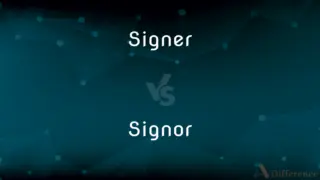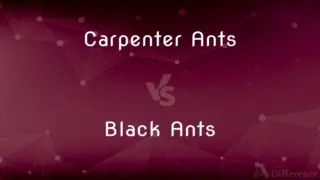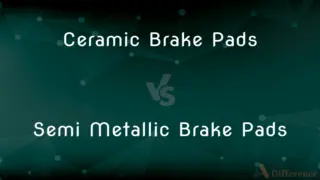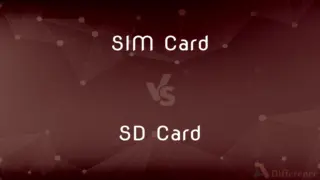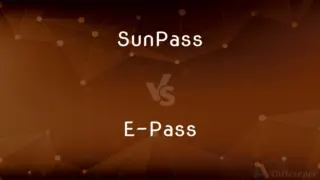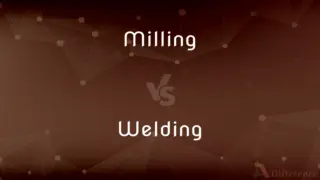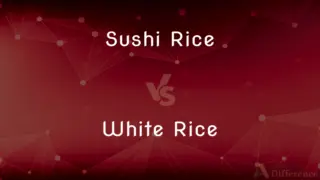Heal vs. Heel — What's the Difference?
By Urooj Arif & Maham Liaqat — Updated on March 7, 2024
Heal focuses on recovery, especially from injury or disease, while Heel relates to the back part of the foot.

Difference Between Heal and Heel
Table of Contents
ADVERTISEMENT
Key Differences
Heal primarily involves the process of making or becoming sound or healthy again, often referring to the body's natural process of recovering from injury or illness. It can also extend to emotional or psychological recovery, emphasizing the restoration of well-being. On the other hand, Heel specifically denotes the back part of the human foot below the ankle. It is anatomically distinct and plays a crucial role in balance, movement, and bearing the body's weight during activities such as walking, running, and standing.
While healing can be a gradual process requiring time, care, and sometimes medical intervention, the heel's function and health are maintained through proper footwear, physical activity, and attention to foot hygiene and care. Conversely, issues with the heel, such as pain or injury, can impede one's ability to move comfortably and may require specific treatments or adjustments to heal.
Heal also extends to metaphorical uses, such as "healing a relationship," which implies mending or restoring it to a healthy state. The heel, however, has its own idiomatic expressions, such as "Achilles' heel," denoting a vulnerability or weak point, despite overall strength.
In the context of verb usage, to heal is an action that results in recovery or restoration, applicable to physical, emotional, or situational contexts. The heel, while primarily a noun, can also function as a verb in specific contexts, such as "to heel a dog," meaning to make the dog walk close by one's side.
The term heal is associated with health, recovery, and restoration, embodying a process or outcome of returning to a state of wholeness. The heel, in contrast, is a specific anatomical part of the body with a critical function in locomotion and balance, also carrying metaphorical meanings in language and culture.
ADVERTISEMENT
Comparison Chart
Primary Meaning
To make or become healthy again
The back part of the human foot
Context of Use
Health, recovery, emotional healing
Anatomy, footwear, idiomatic expressions
Function
Restorative process
Supports balance, movement
Related Expressions
"Healing process," "emotional healing"
"Achilles' heel," "to heel a dog"
Metaphorical Usage
Healing relationships, situations
Indicating a vulnerability or weakness
Compare with Definitions
Heal
To mend or repair (in a figurative sense).
They attended counseling to heal their fractured marriage.
Heel
The back part of the foot below the ankle.
She felt a sharp pain in her heel when she stood up.
Heal
To restore to health or soundness.
The doctor said the wound will heal in a few weeks.
Heel
The part of a shoe or sock that covers the heel of the foot.
His new shoes rubbed against his heel, causing a blister.
Heal
To become healthy or whole again.
It took a long time for her heart to heal after the breakup.
Heel
To follow closely or obediently (often used with dogs).
The trained dog would heel whenever its owner gave the command.
Heal
To alleviate or relieve (pain or distress).
Time can heal the pain of grief.
Heel
The lower, rear part of a loaf of bread.
I only had the heel of the bread left for my sandwich.
Heal
To correct or put right.
The community worked together to heal the divisions among its members.
Heel
To tilt or lean, especially of a ship.
The boat began to heel dangerously to one side in the strong wind.
Heal
To restore to health or soundness; cure
Healed the sick patient.
Heel
The heel is the prominence at the posterior end of the foot. It is based on the projection of one bone, the calcaneus or heel bone, behind the articulation of the bones of the lower leg.
Heal
To ease or relieve (emotional distress)
Only time can heal her grief.
Heel
The rounded posterior portion of the human foot under and behind the ankle.
Heal
To set right; repair
Healed the rift between us.
Heel
The corresponding part of the hind foot of other vertebrates.
Heal
To recover from an illness or injury; return to health.
Heel
A similar anatomical part, such as the fleshy rounded base of the human palm or the hind toe of a bird.
Heal
To experience relief from emotional distress
Gave the grieving family time to heal.
Heel
The part, as of a sock, shoe, or stocking, that covers the heel.
Heal
To be relieved or eliminated
The rift between them finally healed.
Heel
The built-up portion of a shoe or boot, supporting the heel.
Heal
(transitive) To make better from a disease, wound, etc.; to revive or cure.
This bandage will help to heal your cut.
Heel
One of the crusty ends of a loaf of bread.
Heal
(intransitive) To become better or healthy again.
Bandages allow cuts to heal.
Heel
The part of the head of a golf club where it joins the shaft.
Heal
To reconcile, as a breach or difference; to make whole; to free from guilt.
To heal dissensions
Heel
The end of a violin bow where the handle is located.
Heal
(rare) conceal.
Heel
The lower end of a mast.
Heal
A spell or ability that restores hit points or removes a status ailment.
Heel
The after end of a ship's keel.
Heal
Health
Heel
(Botany) The basal end of a plant cutting or tuber used in propagation.
Heal
To cover, as a roof, with tiles, slate, lead, or the like.
Heel
Oppression; tyranny
Under the heel of Stalinism.
The heel of an autocrat.
Heal
To make hale, sound, or whole; to cure of a disease, wound, or other derangement; to restore to soundness or health.
Speak the word only, and my servant shall be healed.
Heel
(Informal) A dishonorable or unscrupulous person.
Heal
To remove or subdue; to cause to pass away; to cure; - said of a disease or a wound.
I will heal their backsliding.
Heel
A tilt, as of a boat, to one side.
Heal
To restore to original purity or integrity.
Thus saith the Lord, I have healed these waters.
Heel
To furnish with a heel or heels.
Heal
To reconcile, as a breach or difference; to make whole; to free from guilt; as, to heal dissensions.
Heel
To repair or replace the heels, as for shoes.
Heal
To grow sound; to return to a sound state; as, the limb heals, or the wound heals; - sometimes with up or over; as, it will heal up, or over.
Those wounds heal ill that men do give themselves.
Heel
(Slang) To furnish, especially with money.
Heal
Health.
Heel
To arm (a gamecock) with gaffs.
Heal
Heal or recover;
My broken leg is mending
Heel
To press or strike with the heel
Heel a horse.
Heal
Get healthy again;
The wound is healing slowly
Heel
To follow at one's heels
The dog won't heel.
Heal
Provide a cure for, make healthy again;
The treatment cured the boy's acne
The quack pretended to heal patients but never managed to
Heel
To tilt or cause to tilt to one side.
Heel
To cover the roots of (a plant) with soil temporarily, as while preparing for a more permanent planting. Often with in
Heeled in the apple saplings until the orchard had been laid out.
Heel
(anatomy) The rear part of the foot, where it joins the leg.
Heel
The part of a shoe's sole which supports the foot's heel.
Heel
The rear part of a sock or similar covering for the foot.
Heel
The part of the palm of a hand closest to the wrist.
He drove the heel of his hand into the man's nose.
Heel
A woman's high-heeled shoe.
Heel
(firearms) The back, upper part of the stock.
Heel
The last or lowest part of anything.
The heel of a mast
The heel of a vessel
Heel
A crust end-piece of a loaf of bread.
Heel
(US) The base of a bun sliced in half lengthwise.
Heel
(informal) A contemptible, unscrupulous, inconsiderate or thoughtless person.
Heel
A headlining wrestler regarded as a "bad guy," whose ring persona embodies villainous or reprehensible traits and demonstrates characteristics of a braggart and a bully.
Heel
(card games) The cards set aside for later use in a patience or solitaire game.
Heel
Anything resembling a human heel in shape; a protuberance; a knob.
Heel
(architecture) The lower end of a timber in a frame, as a post or rafter.
Heel
The obtuse angle of the lower end of a rafter set sloping.
Heel
A cyma reversa.
Heel
(carpentry) The short side of an angled cut.
Heel
(golf) The part of a club head's face nearest the shaft.
Heel
The lower end of the bit (cutting edge) of an axehead; as opposed to the toe (upper end).
Heel
In a carding machine, the part of a flat nearest the cylinder.
Heel
(nautical) The junction between the keel and the stempost of a vessel; an angular wooden join connecting the two.
Heel
(nautical) The act of inclining or canting from a vertical position; a cant.
Heel
To follow at somebody's heels; to chase closely.
She called to her dog to heel.
Heel
To add a heel to, or increase the size of the heel of (a shoe or boot).
Heel
To kick with the heel.
Heel
(transitive) To perform by the use of the heels, as in dancing, running, etc.
Heel
(transitive) To arm with a gaff, as a cock for fighting.
Heel
To hit (the ball) with the heel of the club.
Heel
To make (a fair catch) standing with one foot forward, the heel on the ground and the toe up.
Heel
To incline to one side; to tilt.
Heel
To lean or tip to one side, as a ship; as, the ship heels aport; the boat heeled over when the squall struck it.
Heel
To perform by the use of the heels, as in dancing, running, and the like.
I cannot sing,Nor heel the high lavolt.
Heel
To add a heel to; as, to heel a shoe.
Heel
To arm with a gaff, as a cock for fighting.
Heel
To hit (the ball) with the heel of the club.
Heel
To make (a fair catch) standing with one foot advanced, the heel on the ground and the toe up.
Heel
The hinder part of the foot; sometimes, the whole foot; - in man or quadrupeds.
He [the stag] calls to mind his strength and then his speed,His winged heels and then his armed head.
Heel
The hinder part of any covering for the foot, as of a shoe, sock, etc.; specif., a solid part projecting downward from the hinder part of the sole of a boot or shoe.
Heel
The latter or remaining part of anything; the closing or concluding part.
Heel
Anything regarded as like a human heel in shape; a protuberance; a knob.
Heel
The part of a thing corresponding in position to the human heel; the lower part, or part on which a thing rests
Heel
Management by the heel, especially the spurred heel; as, the horse understands the heel well.
Heel
The lower end of a timber in a frame, as a post or rafter. In the United States, specif., the obtuse angle of the lower end of a rafter set sloping.
Heel
The part of the face of the club head nearest the shaft.
Heel
In a carding machine, the part of a flat nearest the cylinder.
Heel
The bottom of a shoe or boot; the back part of a shoe or boot that touches the ground
Heel
The back part of the human foot
Heel
Someone who is morally reprehensible;
You dirty dog
Heel
One of the crusty ends of a loaf of bread
Heel
The lower end of a ship's mast
Heel
(golf) the part of the clubhead where it joins the shaft
Heel
The piece of leather that fits the heel
Heel
Tilt to one side;
The balloon heeled over
The wind made the vessel heel
The ship listed to starboard
Heel
Follow at the heels of a person
Heel
Perform with the heels;
Heel that dance
Heel
Strike with the heel of the club;
Heel a golf ball
Heel
Put a new heel on;
Heel shoes
Common Curiosities
How long does it typically take for a physical injury to heal?
The healing time for a physical injury varies depending on its severity, the affected body part, and individual health factors.
What does it mean to heal emotionally?
Healing emotionally involves processing and recovering from emotional pain, trauma, or distress, leading to emotional well-being.
Can the heel of the foot affect posture?
Yes, problems with the heel, like pain or structural issues, can affect posture and gait, leading to further discomfort or imbalance.
Can relationships truly heal after a betrayal?
Relationships can heal after a betrayal through communication, forgiveness, and rebuilding trust, but it requires effort from all involved parties.
Can emotional wounds manifest as physical symptoms?
Yes, emotional stress can manifest physically, causing symptoms like headaches, stomachaches, or muscle tension.
How can one support the healing process of a friend?
Supporting a friend's healing can involve offering a listening ear, providing practical help, and showing patience and empathy.
Why is it important to wear the right shoes for heel health?
The right shoes provide necessary support and cushioning, preventing injuries and discomfort in the heel and overall foot.
What role does nutrition play in the healing process?
Proper nutrition provides the body with essential nutrients required for repair and recovery, aiding the healing process.
What are common causes of heel pain?
Common causes include plantar fasciitis, Achilles tendinitis, and wearing poorly fitting or unsupportive footwear.
What are some natural ways to promote healing?
Natural healing methods include adequate rest, hydration, a balanced diet, stress reduction techniques, and gentle exercise.
What is an Achilles' heel in a person?
It refers to a person's specific vulnerability or weakness, despite their overall strengths or capabilities.
What does "time heals all wounds" mean?
This expression suggests that given enough time, emotional pain and difficulties tend to lessen or become more manageable.
How does the heel contribute to athletic performance?
The heel absorbs shock and provides leverage during activities, contributing to stability and efficiency in movements.
How do professionals treat heel injuries?
Treatments may include rest, physical therapy, orthotics, medication, or, in severe cases, surgery.
Is it possible to fully heal from a chronic illness?
While some chronic illnesses can be managed effectively, complete healing may not be possible, and treatment focuses on symptom management.
Share Your Discovery

Previous Comparison
Vary vs. Very
Next Comparison
Distention vs. DistensionAuthor Spotlight
Written by
Urooj ArifUrooj is a skilled content writer at Ask Difference, known for her exceptional ability to simplify complex topics into engaging and informative content. With a passion for research and a flair for clear, concise writing, she consistently delivers articles that resonate with our diverse audience.
Co-written by
Maham Liaqat





